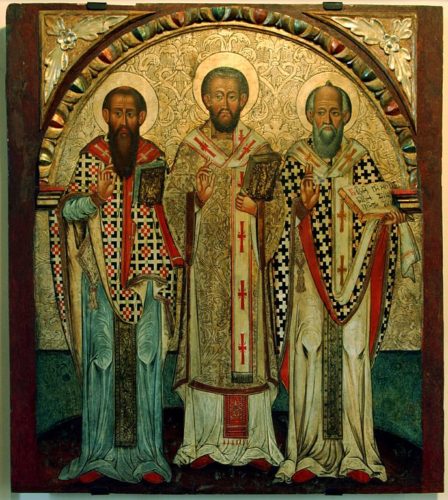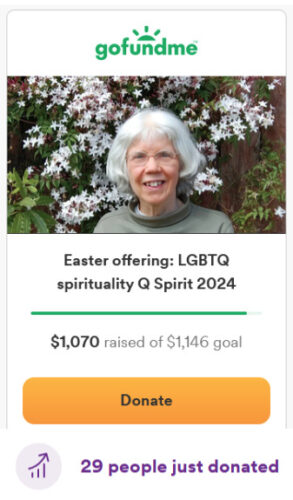Last Updated on January 10, 2024 by Kittredge Cherry

Influential fourth-century saints Basil the Great and Gregory Nazianzus were so close that Gregory said they were like “two bodies with a single spirit.” Their example of love between men can be an inspiration for LGBTQ people and allies today.
The pair is commemorated on many different days in various traditions, including Jan. 2 by Roman Catholic and Anglican churches. In the Episcopal church, Basil’s feast day is June 14 and Gregory’s is May 9.
They longed for a simple life as monks, but went on to serve as bishops: Basil in Caesarea and Gregory in Constantinople, where he presided over the Ecumenical Council that completed the Nicene Creed that is still recited in churches.
Basil and Gregory are so significant that they are recognized as “doctors of the church” in western Christianity, and in the east they are honored (with John Chrysostom) as “the Three Holy Hierarchs” on Jan. 30.
Gregory discusses his deep friendship with Basil in a reading used in the Roman Daily Office for Jan. 2, including these lines:
“We became everything to each other: we shared the same lodging, the same table, the same desires, the same goal. Our love for each other grew daily warmer and deeper. .. We seemed to be two bodies with a single spirit…Each of us was with the other and in the other.”
The words are part of Gregory’s Oration 43, his widely acclaimed funeral sermon for Basil. His soulmate died of illness, but Gregory described himself as “half dead, and, cleft in two, torn away from our great union, and dragging along a life of pain which runs not easily, as may be supposed, after separation from him.” In his funeral oration, Gregory asked Basil to welcome him into heaven when his time came. The sermon is included in his “Selected Works.” His homilies on wealth and poverty are collected in a volume that remains relevant and popular: “On Social Justice: St. Basil the Great.”
Basil and Gregory are usually shown in icons with Saint John Chrysostom between them. The icon at the top of this post shows Basil on the left and Gregory on the right, separated by John. From a contemporary queer perspective, it’s a questionable arrangement, since John is known for his virulent writings against homosexuality. Basil and Gregory also publicly supported the church position that homosexual activity was sinful, but their man-to-man bond was so strong that perhaps the church felt the need to separate them in religious iconography.
Q Spirit is pleased to share the following profile of Basil and Gregory Nazianzus by Terence Weldon, a gay Catholic expert on queer saints.
Saints Basil and Gregory Nazianzus:
Doctors of the Church
By Terence Weldon
(Reposted from Queering the Church with permission)
Two of the most notable saints deserving special attention by queer Christians are St Basil the Great, Bishop of Caesarea in Cappadocia, and his dear friend St Gregory “the theologian”, Bishop of Nazianzus, whose relationship was of such great intimacy that they are frequently described as having shared “one soul in two bodies”. Today, January 2nd, the Church celebrates their joint feast day.
“Then not only did I feel full of veneration for my great Basil because of the seriousness of his morals and the maturity and wisdom of his speeches, but he induced others who did not yet know him to be like him…. The same eagerness for knowledge motivated us…. This was our competition: not who was first but who allowed the other to be first. It seemed as if we had one soul in two bodies”
(The phrase was used by Gregory himself, after the death of his friend Basil, and has been regularly repeated across the sixteen centuries since by many others, including Pope Benedict).
Both are regarded by the Roman Catholic and Orthodox Churches as Doctors of the Faith, and the Eastern Orthodox churches have further honoured them, together with John Chrysostom, with the title “Great Hierarch”.
Basil (330 – 379) and Gregory (c. 329 – 389 or 390) first met and became friends at school in Caesarea, and resumed their friendship in 352, when they were completing their schooling together in Athens.
Basil came from a family of saints. His parents were St. Basil the Elder and St. Emmelia of Cappadocia (in modern Turkey). Some of his brothers and sisters are also honored among the saints. After completing his own schooling, Basil opened a school of oratory, and practised law before deciding to become a monk. He first retired to Pontus to lead the life of a hermit; but finding that Gregory could not join him there, came and settled first at Tiberina (near Gregory’s own home), then at Neocaesarea, in Pontus, where he lived in holy seclusion for some years, and gathered round him a brotherhood of cenobites, among whom his friend Gregory was for a time included. During the next few years, Gregory and Basil together edited some of the exegetical works of Origen. Gregory also helped his friend in the compilation of his famous monastic rule, which became the most enduring rule in the Eastern monastic tradition.
After founding several more monasteries, Basil accepted ordination, and in 373, was appointed bishop of Caesaria. His great learning, eloquence and charity earned him the title of “the Great” during his lifetime, and Doctor of the Church after his death. Gregory returned to Nazianzus, where his father, the local bishop, pressured him to accept ordination, which he did only reluctantly.
However, when the elder Gregory wished to make him a bishop, he fled to join his friend Basil in Pontus. St Basil had organized a monastery in Pontus and had written to Gregory inviting him to come. St Gregory remained with St Basil for several years. In Gregory finally accepted the episcopal office, and was ordained Bishop of Sasima by his friend Basil.
Other then the simple fact of their intimacy, a feature that I find helpful for the position of modern lesbian or gay Catholics, is Gregory’s response to religious hostility. As I have seen repeatedly at this site, and many more LGBT Christians have experienced, the religious fundies can react to explorations of faith from a queer perspective with a great deal of fury, and even accusations of heresy. In the fourth century, the divisions in the Church were not over sexuality or relationships, but about the nature of God, and the controversy over the Arian heresy. Gregory’s response to his attackers is worth pondering:
When Gregory and his congregation had been attacked in their church, while celebrating our Lord’s baptism, by the Arian rabble of Constantinople, in consequence of the report that they were Tritheists, Gregory heard that Theodorus was about to appeal for redness to Theodosius, whereupon the good man wrote that while punishment might possibly prevent recurrence of such conduct, it was better to give an example of long-suffering.
“Let us,” said he, “overcome them by gentleness, and win them by piety; let their punishment be found in their own consciences, not in our resentment. Dry not up the fig-tree that may yet bear fruit.” The Seventh General Council called him “Father of Fathers.”
In his reflection on Gregory for a general audience of August 8th, 2007, Pope Benedict notes that during the Second Ecumenical Council of the Church in 381, Gregory was elected Bishop of Constantinople, and presided over the council:
but he was challenged straightaway by strong opposition, to the point that the situation became untenable. These hostilities must have been unbearable to such a sensitive soul.
What Gregory had previously lamented with heartfelt words was repeated: “We have divided Christ, we who so loved God and Christ! We have lied to one another because of the Truth, we have harboured sentiments of hatred because of Love, we are separated from one another” (Orationes 6: 3; SC 405: 128).
___
 Terence Weldon is an openly gay Catholic who blogs at Queering the Church. Originally from South Africa, he is a partnered father and grandfather based in the United Kingdom.
Terence Weldon is an openly gay Catholic who blogs at Queering the Church. Originally from South Africa, he is a partnered father and grandfather based in the United Kingdom.
___
Top image credit:
17th-century icon of the Three Holy Hierarchs: Basil the Great (left), John Chrysostom (center) and Gregory the Theologian (right) rom Lipie, Historic Museum in Sanok, Poland. (Wikipedia)
___
This post is part of the LGBTQ Saints series by Kittredge Cherry. Traditional and alternative saints, people in the Bible, LGBT and queer martyrs, authors, theologians, religious leaders, artists, deities and other figures of special interest to lesbian, gay, bisexual and transgender and queer (LGBTQ) people and our allies are covered.








This article admits “Basil and Gregory also publicly supported the church position that homosexual activity was sinful”, but also claims (of course) that they were gay lovers anyway without presenting any evidence of romance or sex aside from the usual generic term used in that era for any type of affection. Yes, in this case it was clearly a close friendship, but without any sexual overtones that we know of.
Gracia! !
As much as I wish this served as a good example for lgbt Catholics, I think it’s actually quite unfitting. This is the same Saint Basil who said “If you [O, monk] are young in either body or mind, shun the companionship of other young men and avoid them as you would a flame. For through them the enemy has kindled the desires of many and then handed them over to eternal fire, hurling them into the vile pit of the five cities under the pretense of spiritual love. . . . At meals take a seat far from other young men. In lying down to sleep let not their clothes be near yours, but rather have an old man between you. When a young man converses with you, or sings psalms facing you, answer him with eyes cast down, lest perhaps by gazing at his face you receive a seed of desire sown by the enemy and reap sheaves of corruption and ruin. Whether in the house or in a place where there is no one to see your actions, be not found in his company under the pretense either of studying the divine oracles or of any other business whatsoever, however necessary” (Renunciation of the World). I’d love thoughts on this because these sorts of things are making me despair of being gay and Catholic.
Thanks for saying this. In an effort to not allow what might potentially be queer representation fade from history, it feels like often the pendulum swings far in the other direction to call things queer that might not be. It feels like there’s either churches who take tradition and scripture seriously and will not engage in nuanced conversation about our community, and on the other hand, other groups who accept us but it’s because they don’t seem to take any tradition or scripture very seriously.
As for Basil’s quote, I mean, it seems to work really well for a group of young people who took vows of celibacy. At least he acknowledges that these desires exist and can exist in many places. In the early church it seemed like celibacy and virginity were much more celebrated and pursued than today. People hardly consider the option of desiring a life of celibacy at all, regardless of orientation. It’s just that for us queer folks, celibacy gets forced on us canonically and the door is shut. But I am thankful this is a continuing ecumenical conversation. We can’t give up hope, and we know there are genuine representations of us in history, and those representations loved Christ.